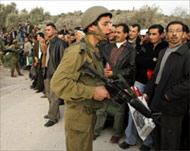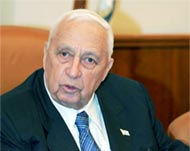Settler-funding a billion dollar question
Israel’s illegal effort since the 1967 Arab-Israeli war to fill the West Bank and Gaza Strip with Jews has grown from the scattered actions of zealous squatters into a network of 142 settlements that house nearly 240,000 people.

Now that Israel plans to spend $2 billion to dismantle just 25 of these enclaves in the West Bank and Gaza – for which US aid has been requested – raises the question of how much money has been poured into the ambitious settlement project, and exactly where it came from.
The official answer: No one knows.
Vice Prime Minister Shimon Peres estimates Israel has spent about $50 billion since 1977, when the hardline Likud government took over from his Labour party. Other former finance ministers and government officials do not discount a price tag – commonly floated but never documented – of $60 billion.
 |
|
Despite the Gaza pullout, some |
“No one eye in the world saw the whole picture,” says Labour Party lawmaker Danny Yatom, a confidant of the late Prime Minister Yitzhak Rabin. “Most of it is not camouflaged, but it is not possible to connect A to B to C to D to E to F to G.”
Calculating an exact figure is impossible because much of the building was financed through winks and nods, an opaque state budget and secret military spending that sometimes violated Israel’s laws and undercut international peacemaking efforts, according to official Israeli inquiries as well as interviews with past and present officials, settlers and their opponents.
Among the methods used, the interviews show, were government subsidies, shadowy land deals, loopholes in military spending, and an auditing bait-and-switch in which US aid was used to free up billions of dollars for spending on the settlements formally opposed by the United States.
Expansion continues
Even today, with preparations under way for demolishing 21 settlements in Gaza and four in the West Bank, housing and roads continue to be built in West Bank settlement blocs Israel wants to keep in a final peace deal with the Palestinians. This contradicts the internationally backed “road map” peace plan to halt settlement expansion.
 |
|
Some outposts, illegal under |
And a government-commissioned inquiry in March revealed similar methods were used to build and expand dozens of unauthorised West Bank “outposts” – set up as flag-showing exercises and usually consisting of a handful of people in mobile homes.
It found widespread government complicity in establishing more than 100 such outposts, and the inquiry’s chief, former prosecutor Talia Sasson, called the government’s actions “a blatant violation of the law”.
Last year, the funding of the outposts came in for sharp criticism from the state controller, the government’s main watchdog. It found at least two cases where the Housing Ministry funded outposts that the military had ordered demolished.
Government policy
Now settler leaders, eager to embarrass Prime Minister Ariel Sharon over his Gaza withdrawal plan, say they had official backing in all their ventures.
“Let me be very, very clear: It’s not a question of dark-of-night grabs, or hide-and-seek or deceit on anyone’s part,” said lawmaker Yitzhak Levy of the pro-settler National Religious Party, who headed ministries in Likud and Labour governments.
“It is government policy,” he said.
The settlements started after 1967 under Labour governments, which sought to confine them to border areas they considered necessary for national security.
Benefits for settlers
But then Likud came to power in 1977, claiming a God-given right to the whole West Bank and Gaza Strip. The chief settlement advocate was Ariel Sharon, the former general who – now as prime minister – has ordered the Gaza pullback.
 |
|
Settlements have carved up |
Using his Cabinet posts between 1977 and 1992 – agriculture, defence and housing – he doled out government grants, low-cost loans and tax breaks to settlers. He also gave birth to the idea of advertising the enclaves as bedroom communities just minutes from Israeli urban centres.
Some settlements close to towns in Israel proper were subsidised by giving the inhabitants tax cuts, cheap mortgages and grants of between $6900 and $57,000 – perks ordinarily reserved for outlying areas.
Maaleh Adumim, the largest settlement with about 30,000
people, received this “priority” status even though it is just 5km from Jerusalem. So did Elkana, an affluent settlement 8km from Israel’s economic hub, Tel Aviv.
Not legal
Settler leader Adi Mintz said even some of the settlers thought the tax breaks for bedroom communities were unfair.
The state also picked up as much as half the tab for hooking up utilities. And pro-settler lawmakers fought to control key ministries such as Construction and Housing, National Infrastructure, and Transportation so they could direct money to settlements.
|
“The state of Israel didn’t want a head-on confrontation with the United States … therefore Israel always did things with winks and nods” Settler leader Adi Mintz |
“When I was at the Ministry of Housing, I set the objective of expanding [settlements in] outlying areas,” said lawmaker Levy.
The classified defence budget further propelled expansion, funding troop deployments to guard settlements, and building fences and wide roads for settlers living among more than 2 million Palestinians who adamantly oppose their presence.
A government official conceded that some uses of military funds “in hindsight … aren’t legal and shouldn’t have been done”.
He spoke on condition of anonymity because he was discussing possible violations of the law by the government.
Winks and nods
At times, government watchdogs balked at the way government funds were being used. Most recently, the
Interior Ministry launched an investigation into the transfer of $2.8 million in 2003 and 2004 from settlement municipalities to a settlement lobby group, which is funding the fight against the Gaza pullout.
 |
|
Washington has indirectly |
Because the state and separate ministerial budgets do not break down outlays by region, it is difficult to identify the flow of money to settlements. Supporters and detractors both say this allowed Israeli governments to hide behind the budget when it came to settlement financing – and forestall friction with Washington.
“The state of Israel didn’t want a head-on confrontation with the United States … therefore Israel always did things with winks and nods,” said Mintz, the settler leader.
Despite its declared opposition to settlements, Washington only began taking action in the early 1990s, when Israel sought billions of dollars in US loan guarantees.
Washington said it would deduct sums that went into settlements dollar for dollar.
US lobby
In 2003, when Israel was granted $9 billion in loan guarantees over three years, the cut was $289.5 million.
Officials familiar with the issue, and speaking on condition of anonymity, say that low figure was reached with the help of the influential pro-Israel lobby, the American Israel Public Affairs Committee, known as AIPAC.
AIPAC officials refused to discuss the issue on the record, but denied they helped to negotiate the numbers.
Israel also used private US donations for which it secured US tax-exempt status, said David Newman, a political scientist at Israel’s Ben Gurion University who researched settlement funding.
US tax laws do not exempt donations for political activities such as settlements. Israel separated the World Zionist Organisation from the quasi-governmental Jewish Agency, a move that allowed donors to inject money into settlements without losing tax exemptions.
Land expropriated
In reality, the two groups operate under one umbrella, with the same officials, departments and administrators overseeing the activities, Newman said.
 |
|
Sharon was a champion of the |
Perhaps the greyest area is how Israel expropriated, confiscated or purchased land for settlements.
During the first 12 years of occupation, more than 4000 hectares of land confiscated by the military for security needs were handed to settlers, according to Defence Ministry statistics quoted in Lords of the Land, a book by Israeli authors Akiva Eldar and Idit Zartel.
Even after Israel’s Supreme Court in 1979 raised the bar for security-related land confiscations, the state seized thousands more hectares (acres) of West Bank land on security grounds and turned it over for settlers, some living in unauthorised enclaves.
The state-funded Jewish National Fund, along with settler groups and their supporters, also bought land from private Palestinians, using middlemen to cloak the sellers’ identity and shield them from attack by other Arabs.
Shaul Goldstein, head of the Gush Etzion Regional Council in the West Bank, said his council recently paid $10,000 for 990 square metres of Palestinian land – about one-twentieth of the cost of land just over the border.